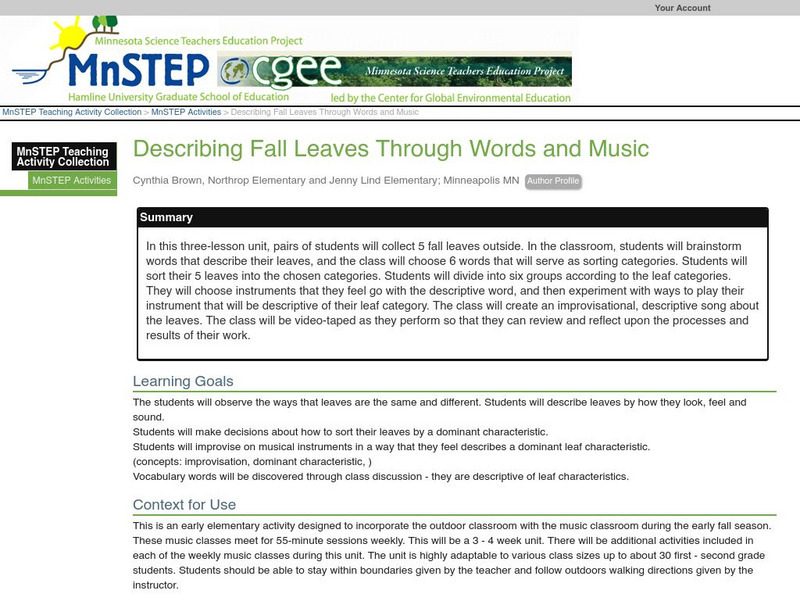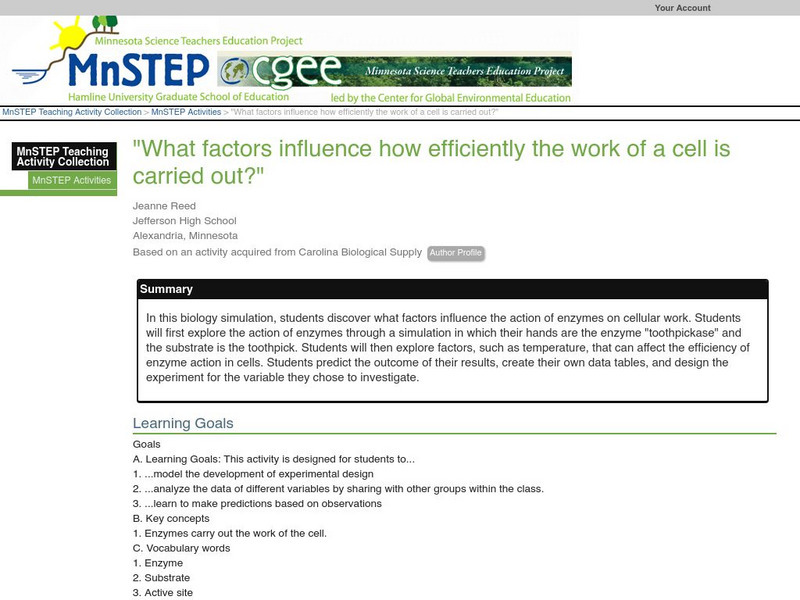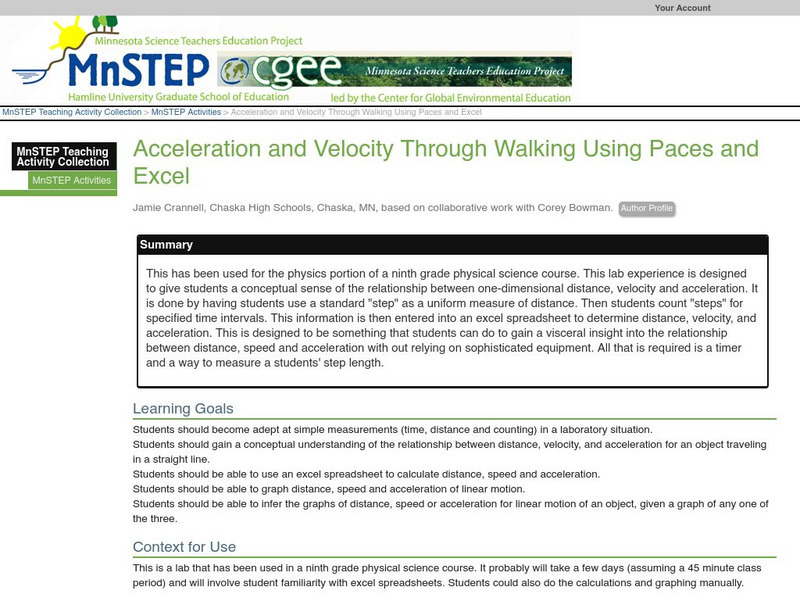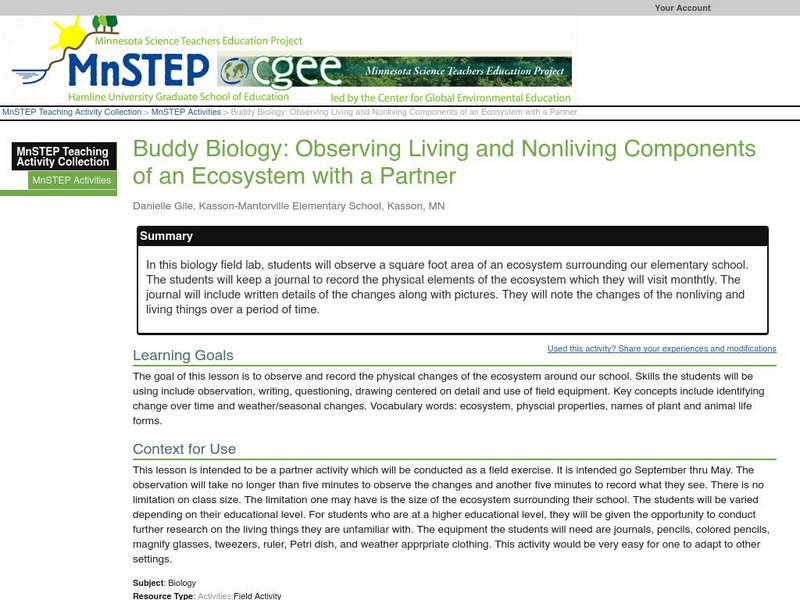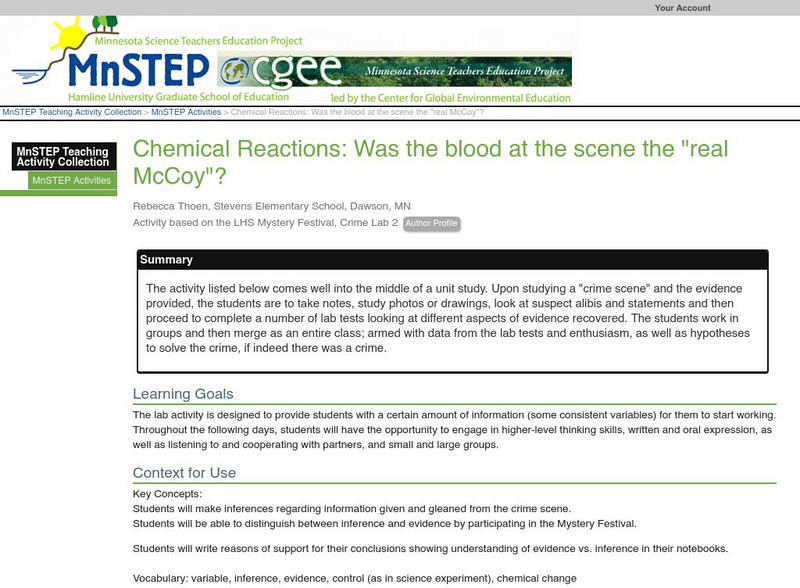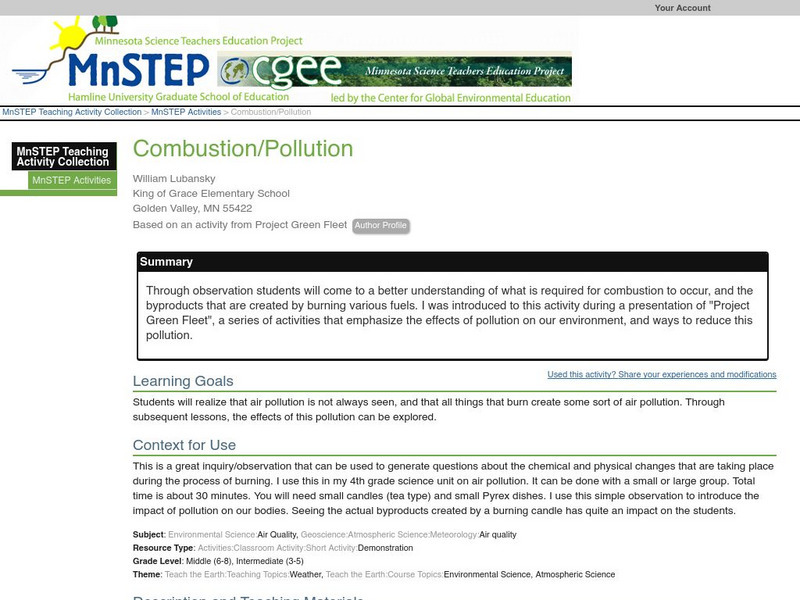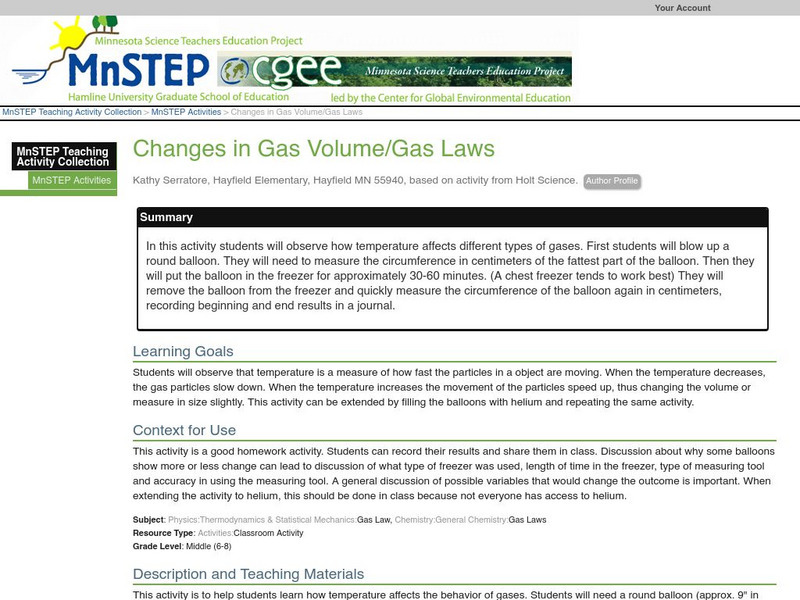Science Education Resource Center at Carleton College
Serc: Describing Fall Leaves Through Words and Music
Students collect, describe, and sort leaves found outside. As a cross-curricular component, they will improvise on musical instruments in a way that they feel describes a dominant leaf characteristic.
Science Education Resource Center at Carleton College
Serc: Determination of Chlorophyll in Olive Oil Using the Vernier Spectrometer
In this activity, students investigate how much chlorophyll is in olive oil using a Varnier Spectrometer.
Science Education Resource Center at Carleton College
Serc: What Factors Influence How Efficiently the Work of a Cell Is Carried Out?
In this biology simulation, students discover what factors influence the action of enzymes on cellular work. Students will first explore the action of enzymes through a simulation in which their hands are the enzyme "toothpickase" and...
Science Education Resource Center at Carleton College
Serc: Acceleration and Velocity Through Walking Using Paces and Excel
This has been used for the physics portion of a ninth grade physical science course. This lab experience is designed to give students a conceptual sense of the relationship between one-dimensional distance, velocity and acceleration.
Science Education Resource Center at Carleton College
Serc: Identifying Macroinvertebrates to Determine Health of Aquatic Ecosystem
In this hands on activity students will learn how to identify basic macroinvertebrate using a dichotomous key. They will complete a chart used by the MPCA and we will discuss why an ecosystem may not be healthy or not.
Science Education Resource Center at Carleton College
Serc: Changing the State of Matter Using Heating and Cooling
In this lesson, students will investigate how different materials changed when heated or cooled. The process in developing the investigation will be inquiry based. Students will have the liberty in choosing the materials and devising how...
Science Education Resource Center at Carleton College
Serc: Observing Living and Non Living Components of an Ecosystem With a Partner
In this activity students will observe a square foot of an ecosystem surrounding our elementary school. They will keep a journal to record the physical elements of their area. It will include both written details and drawings. They will...
Science Education Resource Center at Carleton College
Serc: Observing Living and Nonliving Components of an Ecosystem With a Partner
In this biology field lab, students will observe a square foot area of an ecosystem surrounding our elementary school. The students will keep a journal to record the physical elements of the ecosystem which they will visit monthtly. The...
Science Education Resource Center at Carleton College
Serc: Building Big Educator's Guide Mini Activity Human Arch, Forces
In this physics/engineering activity students physically make an arch by pushing on each other with arms outstretched over head. As long as the pair of students balance each other's force their arch will stand, although it will be weak....
Science Education Resource Center at Carleton College
Serc: Determination of Boyle's Law Through Data Collection
Students develop an understanding of the mathematical relationship between pressure and volume of a gas. Students will practice data collection and graphing skills while also making the connection between force and pressure
Science Education Resource Center at Carleton College
Serc: Adaptations of Plants for Survival in Different Environments
In this activity, students investigate plant adaptations by observing plants in different environments comparing the plants to show similarities and differences. Students will learn about the adaptations plants need in order to survive...
Science Education Resource Center at Carleton College
Serc: Mn Step: Relative Dating Using "The Block"
This lesson involves an innovative strategy for introducing the concept of relative dating using a block of wood that has been painted, damaged, and nailed. The task for students is to analyze the order in which these events happened and...
Science Education Resource Center at Carleton College
Serc: Centripetal Acceleration Lab
For this lab students will explore multiple variables of centripetal acceleration. Students collect data on distance from the center of rotation and angular speed, in order to determine the Centripetal Acceleration. Student also research...
Science Education Resource Center at Carleton College
Serc: Comparing Current Intensities of Series, Parallel, and Complex Circuits
Students will investigate the differences of current in series, parallel, and complex circuits through the construction of a small house containing the different types of circuits.
Science Education Resource Center at Carleton College
Serc: Centripetal Force Activity
In this physics activity, young scholars will simulate a race car on a circular track. Velocity, acceleration, and force vectors will be analyzed at various places along the track. As the students progress in the activity, prompts for...
Science Education Resource Center at Carleton College
Serc:calculate the Molarity of Lemonade Solutions
In this lab activity, students taste different samples of lemonade - rate them and then determine the molarity of sugar and citric acid in the lemonade.
Science Education Resource Center at Carleton College
Serc: Chemical Changes and Healthy Bodies All From Snot!
In this demonstration, students observe the properties of "snot"; determine any changes within the "snot"; record and discuss their findings. This demonstration is done within a unit on the respiratory system. It leads to lively...
Science Education Resource Center at Carleton College
Serc: Air Is Matter
It's difficult at times for younger students to realize that air has mass. Matter is something that has volume (takes up space) and has mass (*can be weighed). Air does take up space, even if we can't see it, and air has weight, even if...
Science Education Resource Center at Carleton College
Serc: Do Water Molecules Have Space Between Them?
In this chemistry lab, students investigate whether water molecules have any space between them by filling a glass with water, and adding salt without the water overflowing. They will also experiment with the temperature of the water.
Science Education Resource Center at Carleton College
Serc: Balloon Racer Project
This project will motivate learners to process and apply Newton's laws of motion to make their vehicle travel as far as possible
Science Education Resource Center at Carleton College
Serc: Chemical Reactions: Was the Blood at the Scene the "Real Mc Coy"?
The activity listed below comes well into the middle of a unit study. Upon studying a "crime scene" and the evidence provided, the students are to take notes, study photos or drawings, look at suspect alibis and statements and then...
Science Education Resource Center at Carleton College
Serc: Atoms and Molecules
As part of the introduction to the Periodic Table of the Elements, students will be introduced to the idea of atoms, molecules, and chemical reactions.
Science Education Resource Center at Carleton College
Serc: Combustion/pollution
Through observation students will come to a better understanding of what is required for combustion to occur, and the byproducts that are created by burning various fuels.
Science Education Resource Center at Carleton College
Serc: Changes in Gas Volume/gas Laws
In this activity students will observe how temperature affects different types of gases. First students will blow up a round balloon. They will need to measure the circumference in centimeters of the fattest part of the balloon. Then...


